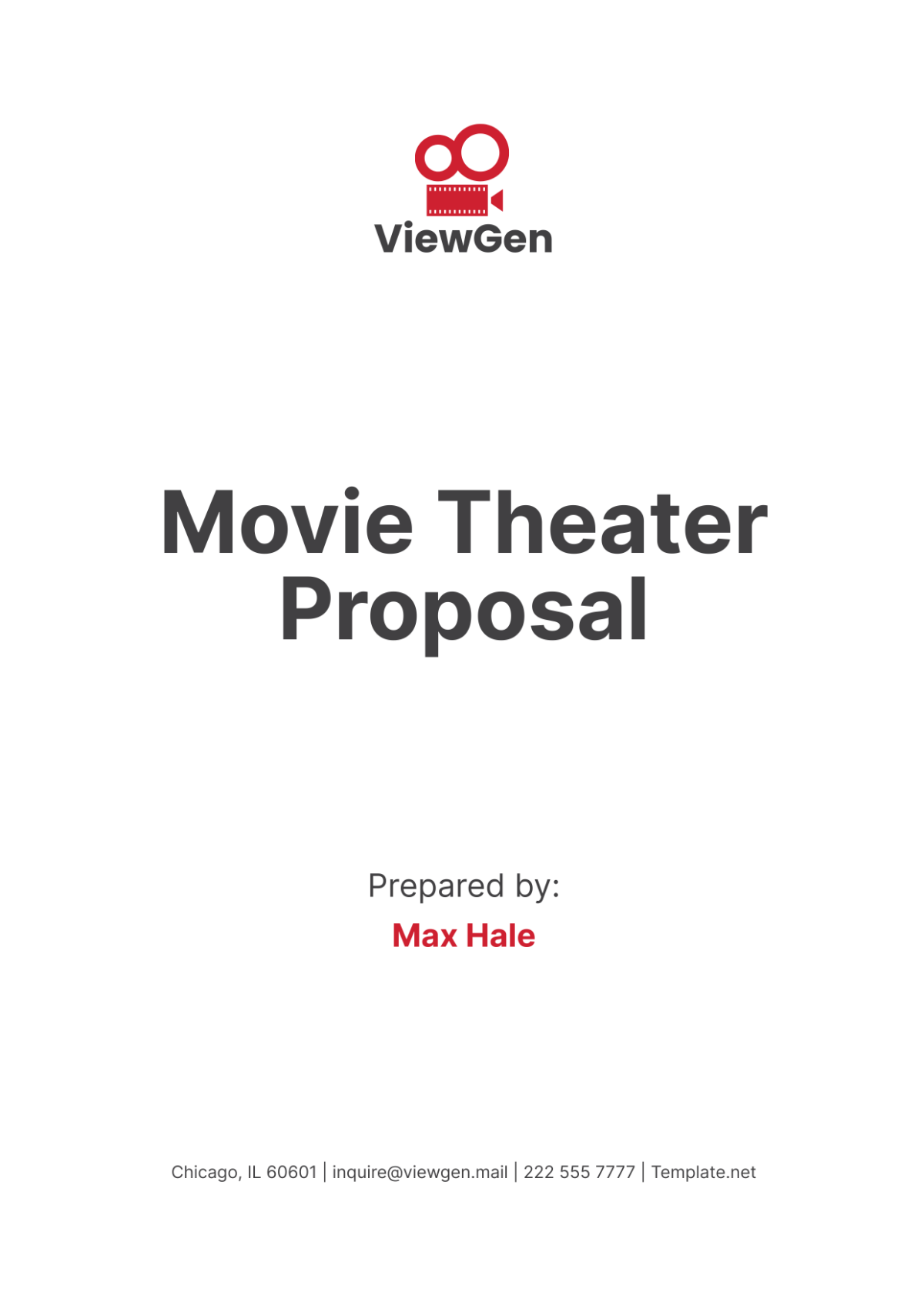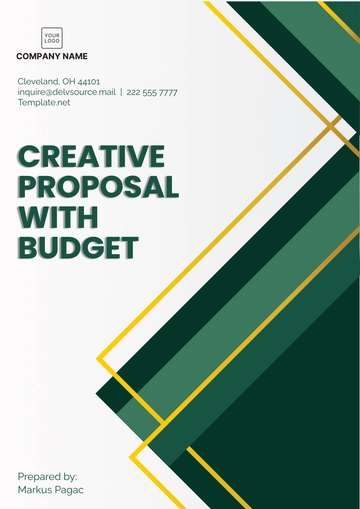Free Movie Theater Proposal

I. Executive Summary
A. Introduction
[Your Company Name], a distinguished leader in entertainment services, proposes to establish an upscale movie theater in the heart of [Location], aiming to redefine the cinema-going experience. This initiative responds to the increasing demand for sophisticated entertainment venues that combine luxury, technology, and community engagement.
The theater will feature state-of-the-art facilities, including advanced audio-visual systems, premium seating options, and immersive cinematic environments, all designed to create an unforgettable experience for movie enthusiasts and families alike.
B. Objectives
Our primary goal is to deliver a world-class entertainment destination that not only entertains but also enriches the cultural fabric of [Location]. By offering unparalleled comfort, superior customer service, and a curated selection of films, we aim to establish [Your Company Name] Theater as the preferred choice for discerning moviegoers.
Financially, we aim to achieve profitability within the first three years of operation, leveraging strategic pricing models and operational efficiencies to maximize revenue while maintaining competitive ticket prices. This profitability will ensure sustainable growth and continuous investment in enhancing the theater's offerings and facilities.
Beyond economic impact, our commitment extends to contributing positively to the local economy through job creation, partnerships with local vendors, and cultural enrichment initiatives that foster community engagement and pride.
C. Key Highlights
Proposed Location: Strategically situated at [Your Company Address], chosen for its accessibility, demographic appeal, and proximity to complementary retail and dining establishments. This location not only maximizes foot traffic but also enhances the theater's visibility and accessibility for both local residents and tourists.
Facility Design: The architectural design emphasizes both functionality and aesthetics, featuring spacious lobby areas, themed decor inspired by cinematic themes, and comfortable seating arrangements that prioritize viewer comfort and convenience.
Offerings: [Your Company Name] Theater will boast multiple screens equipped with the latest in projection technology, offering a diverse lineup of films ranging from mainstream blockbusters to independent cinema. Additionally, our theater will feature premium dining options, including gourmet concessions and full-service dining experiences, elevating the overall movie-watching experience.
II. Market Analysis
A. Industry Overview
The global cinema industry continues to thrive, generating approximately $2 billion in revenue annually. This growth is fueled by evolving consumer preferences toward experiential entertainment and premium cinema offerings that go beyond traditional movie screenings.
In [Location], the cinema market reflects a dynamic landscape with a discerning audience seeking quality entertainment options. By tapping into this demand, [Your Company Name] aims to carve out a niche as a leader in upscale cinema experiences that combine luxury, technology, and cultural relevance.
B. Target Market
Primary Audience: Our primary target demographic includes movie enthusiasts aged 18-45, comprising both residents of [Location] and visitors seeking memorable entertainment experiences. This demographic segment values quality, comfort, and accessibility in their leisure activities and is willing to invest in premium experiences that enhance their overall enjoyment.
Secondary Audience: Families seeking family-friendly entertainment options and corporate clients looking for venue options for private screenings and events. By catering to these diverse segments, [Your Company Name] Theater aims to maximize attendance and revenue streams throughout the year.
C. Competitive Analysis
Local Competitors: Analysis of existing theaters in [Location] reveals a mix of traditional multiplexes and smaller independent theaters. While these venues offer diverse film selections, [Your Company Name] differentiates itself through superior technology, exclusive partnerships with film distributors, and a commitment to exceptional customer service.
Unique Selling Proposition (USP): Our key differentiators include a focus on premium customer experiences, such as luxury seating options, gourmet dining choices, and exclusive film screenings that cater to varied audience preferences. By offering a curated selection of films and personalized service, [Your Company Name] Theater aims to establish a loyal customer base and attract new patrons seeking elevated entertainment experiences.
III. Business Strategy
A. Product Offering
Movie Screens: [Your Company Name] Theater will feature 50 state-of-the-art screens, including 20 screens equipped with 3D technology and 30 screens with IMAX capabilities. Each screen will be optimized for clarity and immersive sound, enhancing the viewing experience for our audience.
Dining Experience: Partnering with renowned chefs and local culinary experts, we will offer a diverse menu of gourmet concessions and full-service dining options. From artisanal snacks to chef-inspired meals delivered directly to seats, our dining experience will complement the cinematic journey, providing patrons with a complete entertainment package.
Membership Programs: [Your Company Name] Theater will introduce tiered membership programs designed to enhance customer loyalty and engagement. Members will enjoy benefits such as priority booking, discounted ticket prices, exclusive access to premieres and events, and personalized concierge services, ensuring a seamless and rewarding experience with every visit.
B. Marketing and Sales
Pre-launch Campaign: Prior to our grand opening, [Your Company Name] Theater will initiate a robust marketing campaign aimed at building anticipation and driving ticket sales. Strategies will include teaser trailers, social media promotions, partnerships with local influencers and media outlets, and special promotional events to introduce the theater's amenities and offerings to the community.
Pricing Strategy: Our pricing strategy will be carefully calibrated to reflect the premium nature of our services while remaining competitive within the local market. We will offer flexible pricing options, including premium rates for enhanced experiences such as IMAX screenings and gourmet dining packages, as well as discounted rates for matinees, group bookings, and special promotions.
Loyalty Programs: To foster long-term customer loyalty, [Your Company Name] Theater will implement comprehensive loyalty programs tailored to reward frequent visitors and incentivize repeat business. Benefits will include points-based rewards, member-exclusive discounts on concessions and merchandise, and special invitations to exclusive screenings and events, encouraging patrons to choose [Your Company Name] Theater as their preferred entertainment destination.
C. Operations Plan
Staffing: Our recruitment strategy will prioritize hiring skilled professionals across various roles, including customer service representatives, technical support staff, culinary experts, and hospitality managers. Training programs will be implemented to ensure that all team members uphold our commitment to excellence in service delivery and customer satisfaction.
Technology Infrastructure: [Your Company Name] Theater will invest in cutting-edge technology to streamline operations and enhance the overall guest experience. This includes state-of-the-art digital ticketing systems for seamless booking and entry, robust security measures to safeguard customer data and ensure a safe environment, and ongoing maintenance of audio-visual equipment to deliver optimal performance during screenings.
IV. Financial Projections
A. Revenue Forecast
Based on market research and projected attendance rates, [Your Company Name] Theater anticipates generating approximately $50 million in revenue during its first year of operation. Revenue streams will be diversified, encompassing ticket sales, concessions, dining experiences, merchandise sales, and venue rentals for private events and corporate functions.
Annual revenue is forecasted to grow steadily, reaching $70 million by year three, driven by increasing brand awareness, customer loyalty, and strategic marketing initiatives aimed at expanding our audience base and maximizing occupancy rates.
B. Cost Analysis
Initial Investment: The establishment of [Your Company Name] Theater requires an initial capital investment of approximately $100 million. This investment will cover construction costs, acquisition of state-of-the-art projection and sound equipment, interior design and furnishings, pre-launch marketing campaigns, and initial operating expenses.
Operational Costs: Ongoing operational expenses include rent, utilities, payroll for staff members, maintenance of facilities and equipment, licensing fees, and marketing expenditures. These costs will be closely monitored and managed to ensure efficient resource allocation and sustainable profitability.
C. Profitability Timeline
[Your Company Name] Theater is projected to achieve break-even within Year 2 of operations, with profitability expected from Year 3 onwards. This timeline is based on conservative revenue projections and prudent cost management strategies aimed at optimizing operational efficiency and minimizing overhead expenses.
Return on Investment (ROI): Investors can expect a favorable ROI, with projected returns of 15% over a 5-year period. Factors contributing to ROI include revenue growth, cost containment measures, and strategic expansion opportunities within the cinema and entertainment sector.
D. ROI Breakdown
Investment Overview
Investment Category | Amount (in millions USD) |
|---|---|
Construction and Facility Setup | $40 million |
Acquisition of Technology and Equipment | $30 million |
Pre-launch Marketing and Promotional Campaigns | $15 million |
Initial Operating Expenses | $15 million |
Revenue Streams
Ticket Sales: 60% of total revenue
Concessions and Dining Experiences: 20% of total revenue
Merchandise Sales: 5% of total revenue
Venue Rentals: 15% of total revenue
Cost Structure
Operational Costs Breakdown:
Fixed Costs: 40% of total expenses
Variable Costs: 55% of total expenses
Depreciation and Amortization: 5% of total expenses
Profitability and ROI Analysis
Break-even Point: Year 2
Profit Margin: Stabilizes at 20% by Year 3
Return on Investment (ROI): 15% over 5 years
V. Implementation Plan
A. Timeline
Construction Phase: [Your Company Name] Theater's construction is scheduled to commence in [Month/Year] and expected to be completed within 60 months. This timeline includes site preparation, building construction, installation of specialized equipment, and interior furnishing to create a welcoming and immersive environment for patrons.
Pre-launch Activities: Leading up to the grand opening, a series of pre-launch activities will be undertaken to generate excitement and anticipation within the community. This includes teaser events, promotional campaigns, media engagements, and collaborative efforts with local influencers and community stakeholders to showcase [Your Company Name] Theater's unique offerings and amenities.
Grand Opening: The official launch of [Your Company Name] Theater is scheduled for [Month/Year]. This milestone event will coincide with the release of a highly anticipated blockbuster film to maximize attendance and media coverage. The grand opening will feature red carpet festivities, exclusive screenings, and VIP experiences to highlight the theater's premium services and establish a memorable debut in the entertainment landscape of [Location].
B. Resource Allocation
Budget Allocation: A detailed budget plan has been devised to allocate resources efficiently across key areas, including construction costs, equipment procurement, marketing initiatives, operational setup, and contingencies. This ensures that financial resources are strategically utilized to support the successful establishment and ongoing operation of [Your Company Name] Theater.
Human Resources: Recruitment efforts are underway to assemble a dedicated team of professionals across various disciplines, including management, customer service, technical support, culinary services, and marketing. Comprehensive training programs will be implemented to equip staff with the skills and knowledge necessary to deliver exceptional service and uphold [Your Company Name] Theater's commitment to quality and customer satisfaction.
Organizational Structure: An organizational framework has been established to define roles, responsibilities, and reporting lines within [Your Company Name] Theater. This structure promotes accountability, efficiency, and seamless coordination across departments, ensuring smooth operations and effective decision-making throughout the pre-launch, launch, and post-launch phases.
C. Risk Management
Risk Assessment: A comprehensive risk assessment has identified potential challenges and uncertainties that may impact the successful launch and operation of [Your Company Name] Theater. These include economic fluctuations, competitive pressures, regulatory compliance, technological disruptions, and unforeseen events such as natural disasters or public health emergencies.
Mitigation Strategies: Mitigation strategies have been developed to proactively address identified risks and minimize their impact on operations and profitability. These strategies include contingency planning, insurance coverage, diversification of revenue streams, strategic partnerships, and ongoing monitoring and adaptation to changing market conditions and external factors.
VI. Conclusion
A. Summary of Benefits
Economic Impact: The establishment of [Your Company Name] Theater will generate significant economic benefits for [Location], including job creation, increased tourism, and enhanced revenue opportunities for local businesses through partnerships and collaborations. By stimulating economic activity, [Your Company Name] Theater will contribute to the overall prosperity and vitality of the community.
Cultural Enrichment: Beyond economic contributions, [Your Company Name] Theater will serve as a cultural hub for film appreciation, artistic expression, and community engagement. Through curated film selections, educational programs, and collaborative initiatives with local artists and cultural institutions, the theater will enrich the cultural fabric of [Location] and foster a sense of pride and identity among residents.
Long-term Viability: [Your Company Name] Theater is poised for long-term success and sustainability in the competitive entertainment industry. By delivering unparalleled entertainment experiences, embracing technological advancements, and responding to evolving consumer preferences, the theater will maintain its relevance and appeal to diverse audience segments, ensuring continued growth and profitability over the years to come.
B. Call to Action
Approval and Support: We invite stakeholders, investors, and community leaders to endorse and support the establishment of [Your Company Name] Theater. Your investment and partnership will play a pivotal role in realizing this visionary project and delivering exceptional entertainment experiences to [Location] and beyond.
Next Steps: Moving forward, [Your Company Name] Theater will proceed with regulatory approvals, finalization of contractual agreements with suppliers and partners, and continued preparations for the grand opening. We look forward to celebrating the success of [Your Company Name] Theater as a premier destination for cinematic excellence and cultural enrichment.
- 100% Customizable, free editor
- Access 1 Million+ Templates, photo’s & graphics
- Download or share as a template
- Click and replace photos, graphics, text, backgrounds
- Resize, crop, AI write & more
- Access advanced editor
Develop proposals with the Movie Theater Proposal Template from Template.net. It's customizable and editable, designed for professional presentation. Utilize our Ai Editor Tool to outline offerings and benefits, persuading stakeholders and securing opportunities for your movie theater.
You may also like
- Business Proposal
- Research Proposal
- Proposal Request
- Project Proposal
- Grant Proposal
- Photography Proposal
- Job Proposal
- Budget Proposal
- Marketing Proposal
- Branding Proposal
- Advertising Proposal
- Sales Proposal
- Startup Proposal
- Event Proposal
- Creative Proposal
- Restaurant Proposal
- Blank Proposal
- One Page Proposal
- Proposal Report
- IT Proposal
- Non Profit Proposal
- Training Proposal
- Construction Proposal
- School Proposal
- Cleaning Proposal
- Contract Proposal
- HR Proposal
- Travel Agency Proposal
- Small Business Proposal
- Investment Proposal
- Bid Proposal
- Retail Business Proposal
- Sponsorship Proposal
- Academic Proposal
- Partnership Proposal
- Work Proposal
- Agency Proposal
- University Proposal
- Accounting Proposal
- Real Estate Proposal
- Hotel Proposal
- Product Proposal
- Advertising Agency Proposal
- Development Proposal
- Loan Proposal
- Website Proposal
- Nursing Home Proposal
- Financial Proposal
- Salon Proposal
- Freelancer Proposal
- Funding Proposal
- Work from Home Proposal
- Company Proposal
- Consulting Proposal
- Educational Proposal
- Construction Bid Proposal
- Interior Design Proposal
- New Product Proposal
- Sports Proposal
- Corporate Proposal
- Food Proposal
- Property Proposal
- Maintenance Proposal
- Purchase Proposal
- Rental Proposal
- Recruitment Proposal
- Social Media Proposal
- Travel Proposal
- Trip Proposal
- Software Proposal
- Conference Proposal
- Graphic Design Proposal
- Law Firm Proposal
- Medical Proposal
- Music Proposal
- Pricing Proposal
- SEO Proposal
- Strategy Proposal
- Technical Proposal
- Coaching Proposal
- Ecommerce Proposal
- Fundraising Proposal
- Landscaping Proposal
- Charity Proposal
- Contractor Proposal
- Exhibition Proposal
- Art Proposal
- Mobile Proposal
- Equipment Proposal
- Student Proposal
- Engineering Proposal
- Business Proposal





























